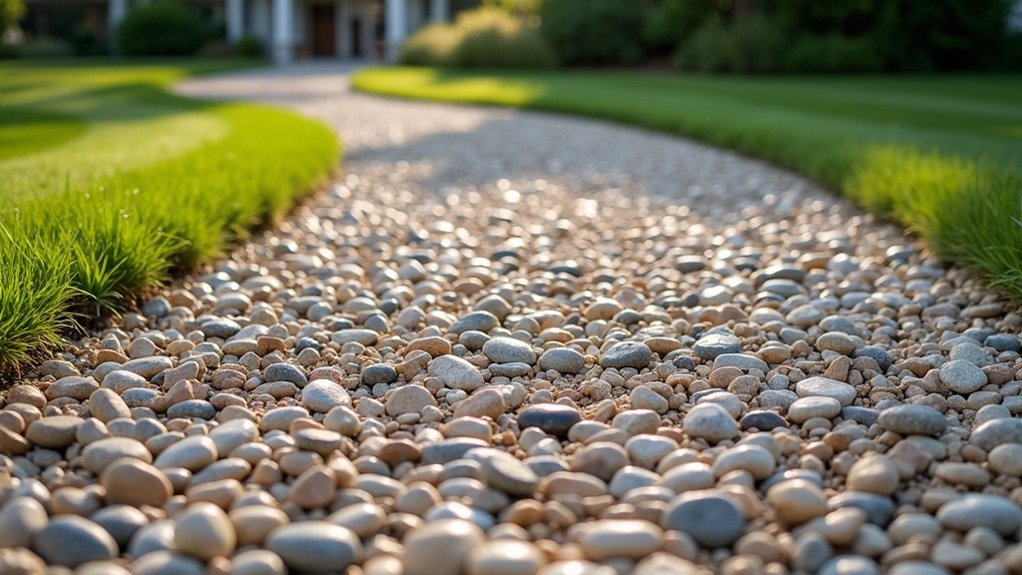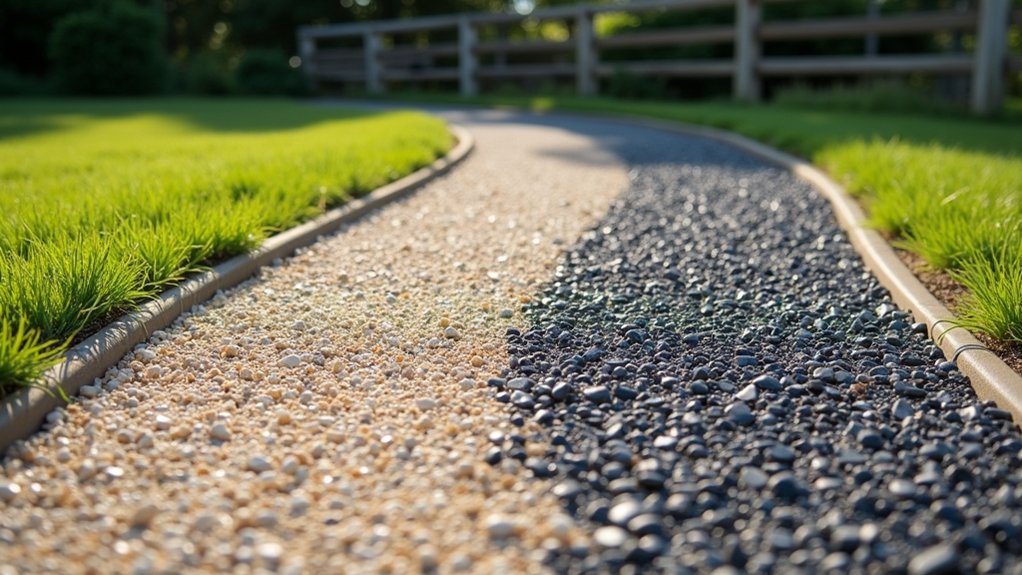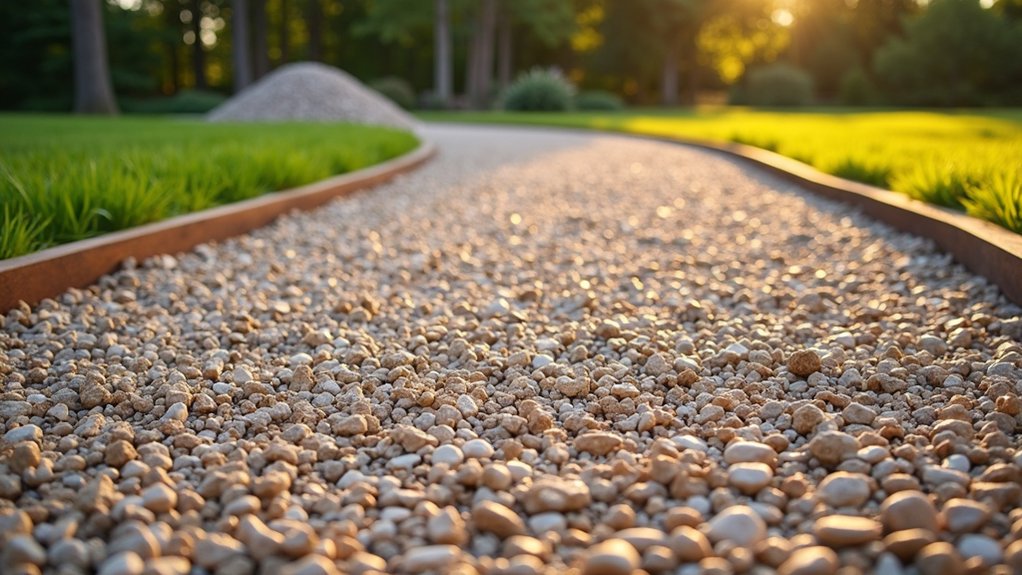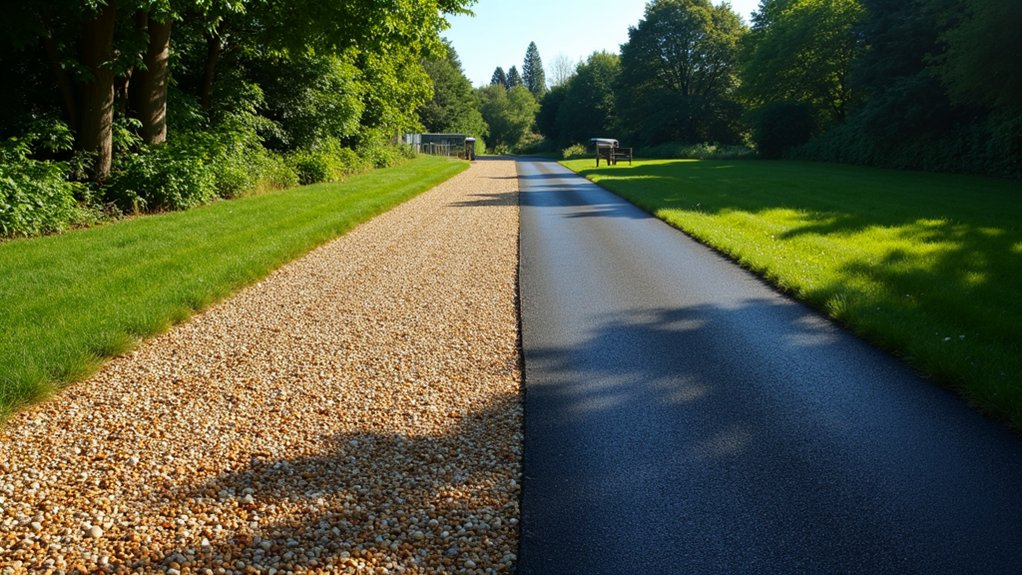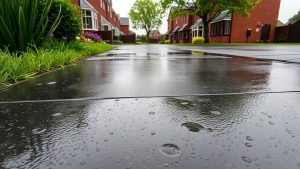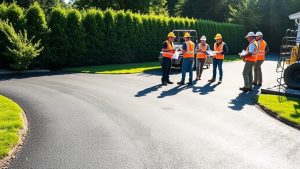For a gravel driveway, aim for a minimum depth of 18 cm (7 inches) for residential use. It’s advisable to include a sub-base of 10-15 cm (4-6 inches) using MOT Type 1 aggregate for added stability. Start with coarse angular stones as a base, then layer smaller aggregates, and finish with finer materials for a smooth surface. Proper compaction is crucial for durability. Additionally, considering design elements can significantly improve your driveway’s performance and drainage.
Table of Contents
ToggleKey Takeaways
- The ideal depth for a gravel driveway is 18 cm (7 inches) for residential properties.
- Incorporate a sub-base depth of 100-150 mm (4-6 inches) for effective drainage and stability.
- Employ a layering technique: start with coarse stones at the base, add smaller aggregates in the middle, and finish with finer materials on top.
- Proper compaction of each layer is vital to prevent shifting and enhance durability.
- Regular maintenance, such as regrading, is key to keeping your driveway functional and looking good.
Recommended Depth for Gravel Driveways
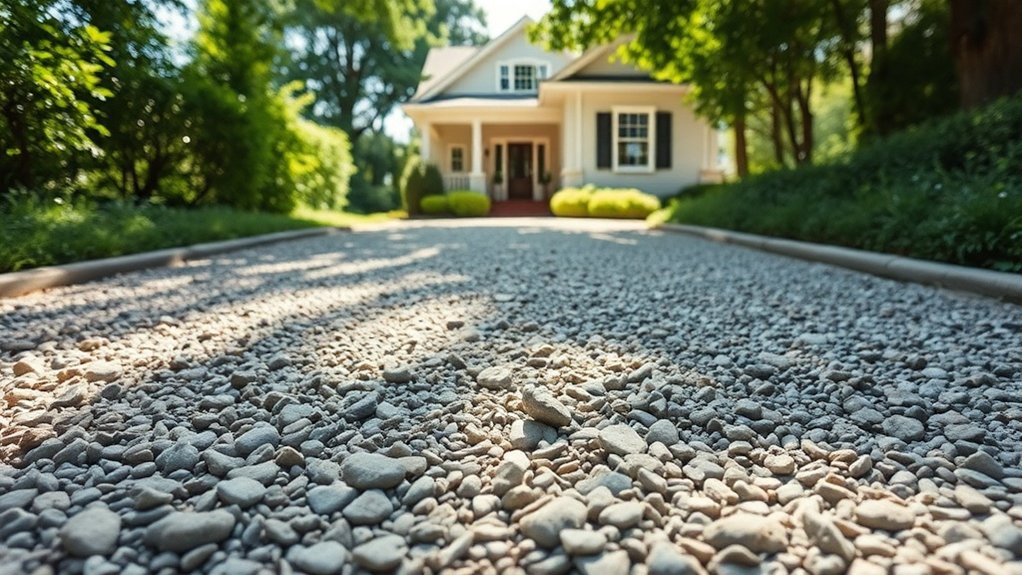
When planning a gravel driveway, a depth of around 18 centimetres (7 inches) is generally recommended for residential use, especially if you’re incorporating pavers for added stability. This depth strikes a good balance between functionality and aesthetics, providing a solid surface while enhancing the overall look of your driveway. If you choose to include a sub-base, the total depth should be between 30 to 45 centimetres (12 to 18 inches) to ensure proper drainage. It’s crucial to use different types of gravel; start with larger crushed stones for the base layer to provide strength, then add a stabilising intermediate layer, and finish with a finer top layer for a smooth surface. Additionally, using TRUEGRID pavers can significantly enhance the longevity of your driveway.
Layering and Materials for Gravel Driveways
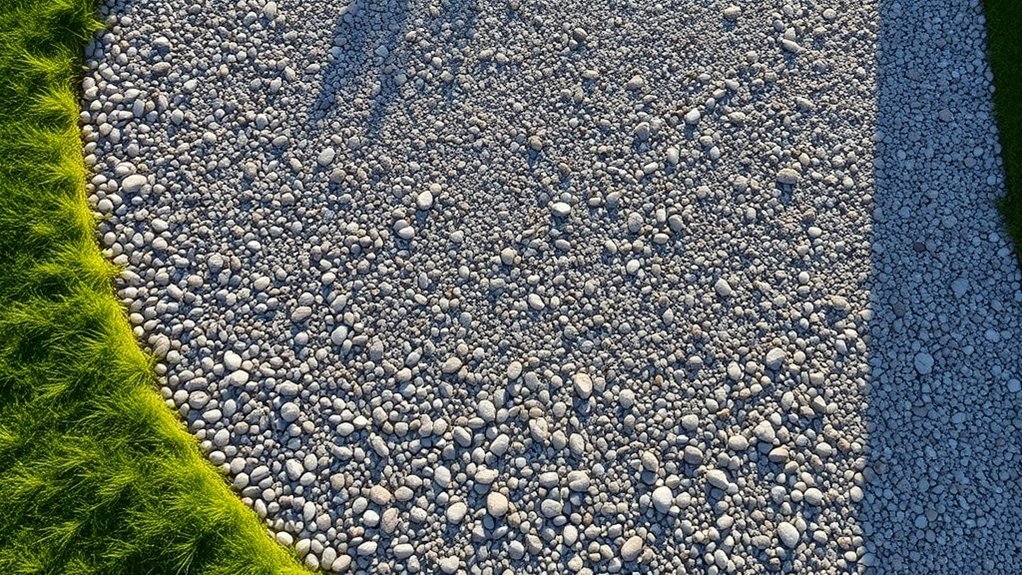
To build a durable gravel driveway, it’s crucial to understand the layering and materials involved.
Begin with a coarse base layer using angular stones (sizes #3 or #4) to ensure proper drainage and support. The middle layer should consist of smaller aggregates, such as crushed stone #57 or #411, mixed with stone dust to enhance stability and drainage. Proper compaction of the base layer gravel is essential to create a solid foundation.
For the top layer, opt for finer materials like pea gravel or decomposed granite, which provide an attractive finish while ensuring proper compaction.
It’s important to spread each layer evenly and compact thoroughly before adding the next to prevent shifting and maintain structural integrity.
Sub-Base Preparation and Depth
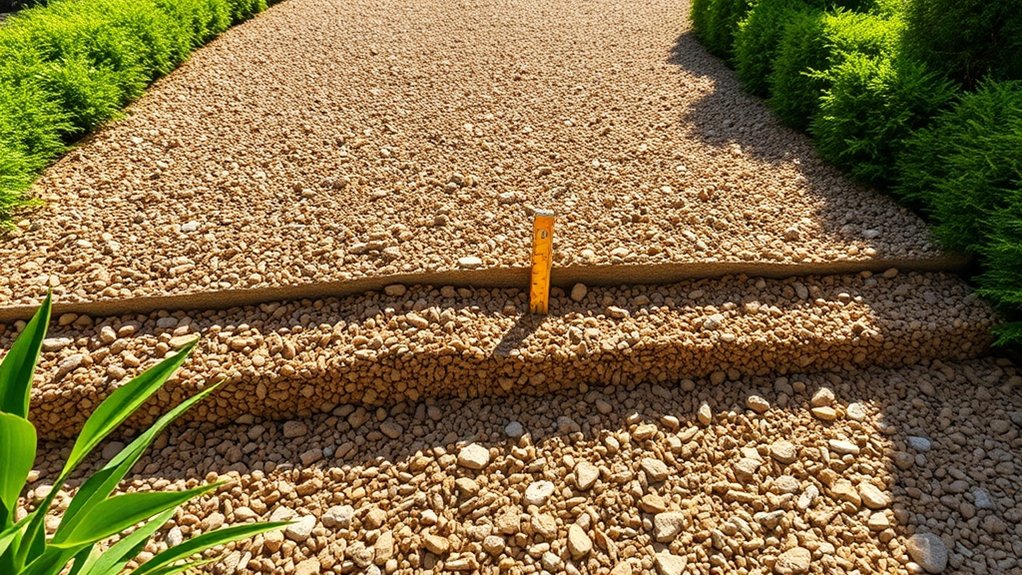
After choosing the right materials and layering techniques for your gravel driveway, the next crucial step is preparing the sub-base and determining its depth. Aim for a sub-base depth of 100-150mm (4-6 inches) to ensure stability and proper drainage. This depth is essential for supporting the weight of vehicles and preventing deformation. For the best results, use MOT Type 1 aggregate, which compacts well. Ensure the base is flat and well-compacted to promote even distribution. It’s also important to slope the sub-base away from any structures to aid in drainage and prevent water pooling. Proper compaction during installation will save you from costly repairs down the line and help maintain the integrity of your driveway, allowing for effective stormwater management and minimising erosion risks.
Excavation and Site Preparation
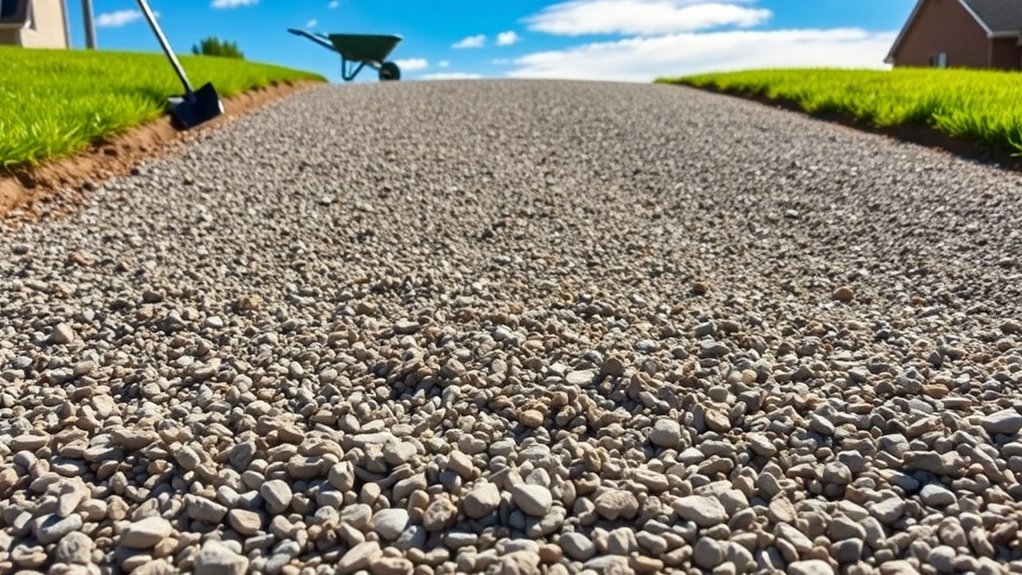
Excavation and site preparation are essential for a long-lasting gravel driveway, requiring careful execution. Here are the key steps to ensure stability:
1. Mark and Layout: Use marking paint to outline the driveway path, ensuring it follows the natural slope for effective drainage.
Be sure to check local regulations regarding width and drainage requirements.
2. Excavation Techniques: Remove topsoil and organic material to a depth of 150 to 300mm, clearing loose soil to reveal stable ground suitable for compaction.
3. Soil Compaction: Employ vibratory compactors or rollers to thoroughly compact the soil, ensuring a uniform surface to prevent settling and potholes.
Gravel Depth for Heavy Traffic and Commercial Use
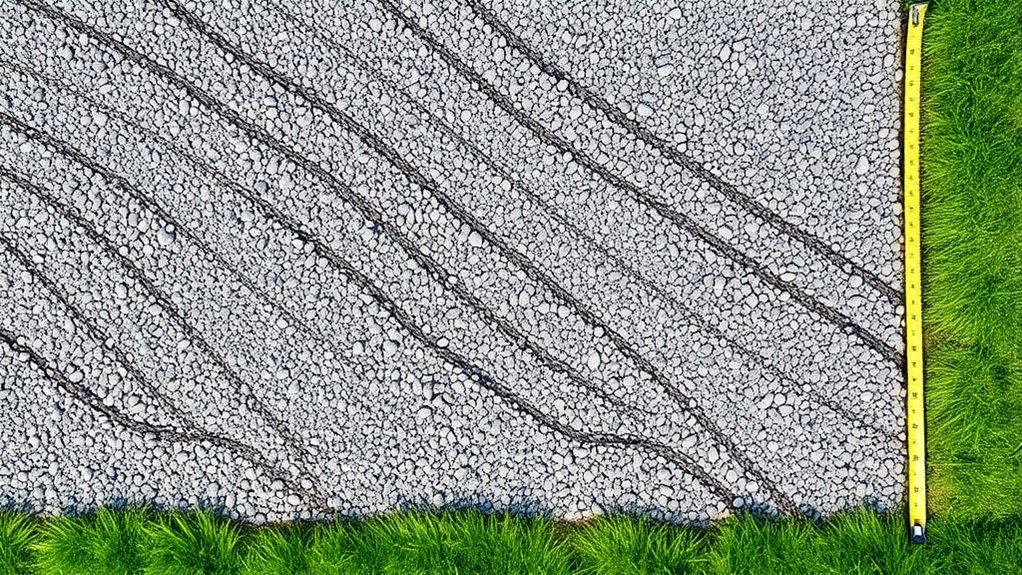
When planning a gravel driveway for heavy traffic, such as in commercial settings, the depth of the gravel is crucial for durability. A total depth of 25 to 30 centimetres is recommended.
Begin with a base layer of 15 to 20 centimetres of large angular gravel (like Type 1) for strength and drainage. Next, add an intermediate layer of 5 to 8 centimetres of medium-sized gravel (such as Type 57) for stability.
Finally, finish with a top layer of 5 to 8 centimetres of fine gravel (like Type 8) for a smooth surface. Choosing the right materials and layering effectively will help with load distribution, reduce rutting, and withstand frequent heavy vehicle traffic, ensuring your driveway lasts.
Maintenance and Longevity Considerations
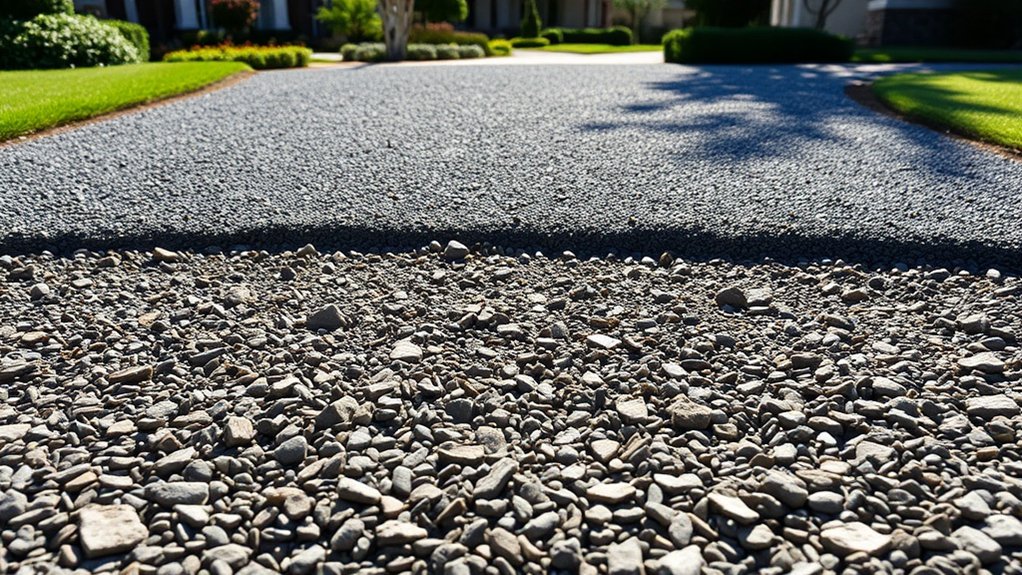
To ensure your gravel driveway remains functional and lasts longer, regular regrading is crucial.
This process not only smooths out uneven surfaces but also improves drainage, preventing water build-up that can cause erosion.
By sticking to a regular maintenance routine, you can significantly extend the lifespan and usability of your driveway.
For instance, regrading once a year can help maintain its appearance and performance.
Regrading Frequency Guidelines
Understanding how often to regrade gravel driveways is essential for keeping them in good condition and extending their lifespan. Proper maintenance can significantly minimise the need for costly repairs. Here’s a simple guide:
- High traffic: Regrade every 10 days to prevent damage to the surface.
- Moderate traffic: Regrade every 3-4 weeks to avoid potholes and ruts.
- Low traffic: Regrade at least once a season or annually for very low usage.
Regularly checking these guidelines ensures your driveway performs well.
Additionally, consider seasonal changes and inspect after storms to determine if regrading is needed. Following these recommendations will help improve your driveway’s durability and functionality.
Drainage Design Importance
Regrading alone cannot solve the complex challenges of water management in gravel driveways. Effective drainage design is crucial for extending the life of driveways and reducing maintenance. By incorporating proper drainage solutions, such as ditches and crowned surfaces, you can effectively manage water runoff and prevent erosion.
| Aspect | Recommended Practice | Purpose |
|---|---|---|
| Ditch Depth | 0.5 to 0.6 metres | To manage runoff volume |
| Side Slope Ratio | 2:1 horizontal to vertical | To ensure stability |
| Drainage Component | Culverts under driveways | To allow uninterrupted vehicle access |
Impact of Local Rainfall on Depth Decisions
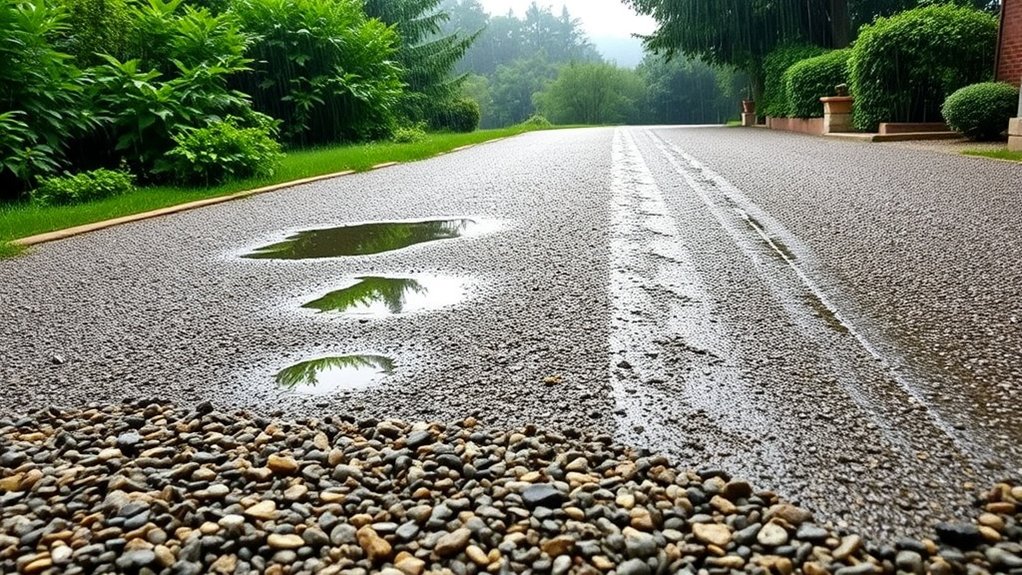
When assessing the depth of your gravel driveway, it’s crucial to take local rainfall patterns into account.
In areas with significant rainfall, you’ll need to adjust the gravel depth to ensure proper drainage and prevent water from pooling.
For instance, if you live in a region prone to heavy rain, increasing the depth can help maintain a stable surface.
Implementing effective drainage solutions will also improve the functionality and lifespan of your driveway in damp conditions.
Assessing Local Rainfall Patterns
How do local rainfall patterns affect the depth of your gravel driveway? Understanding rainfall variability is crucial because it impacts drainage and the lifespan of your driveway.
Here are three key factors to consider:
- Rainfall Intensity: In areas with heavy rainfall, deeper gravel layers are necessary to manage stormwater effectively and prevent washout.
- Soil Type: If your soil is poorly draining, such as clay, you’ll need a thicker gravel layer to improve drainage during downpours.
- Driveway Slope: Steep driveways require more gravel depth to help control rapid runoff and reduce erosion.
Adjusting Gravel Depth Accordingly
Local rainfall patterns significantly affect how deep your gravel driveway should be. In regions with high annual rainfall, a gravel depth of 12-18 inches is advisable to prevent waterlogging and ensure stability. This depth promotes effective drainage, minimising surface pooling and erosion.
In contrast, areas with low rainfall can manage with a shallower depth of 4-6 inches.
To improve drainage and structural integrity, consider using a layered gravel approach. Start with larger gravel as a base, followed by medium-sized pieces, and finish with fine gravel for a neat appearance.
Drainage Solutions for Wet Areas
To effectively manage water accumulation in wet areas, it’s crucial to implement reliable drainage solutions for the longevity and stability of your gravel driveway.
Here are some effective drainage techniques suited to local rainfall patterns:
- French Drains: These are installed beneath the gravel layers to redirect both groundwater and surface water away from the driveway.
- Linear Drains: Perfect for capturing surface water flow, these drains are ideal for handling consistent runoff across the driveway.
- Culverts: Positioned under the driveway, culverts allow water to pass through without disrupting vehicle access.
Choosing the right drainage solution can prevent issues like erosion and potholes, ensuring your driveway remains in good condition. Additionally, implementing Sustainable Drainage Systems (SuDS) can enhance natural water absorption, further protecting your driveway from water-related damage.
Best Practices for Gravel Driveway Installation
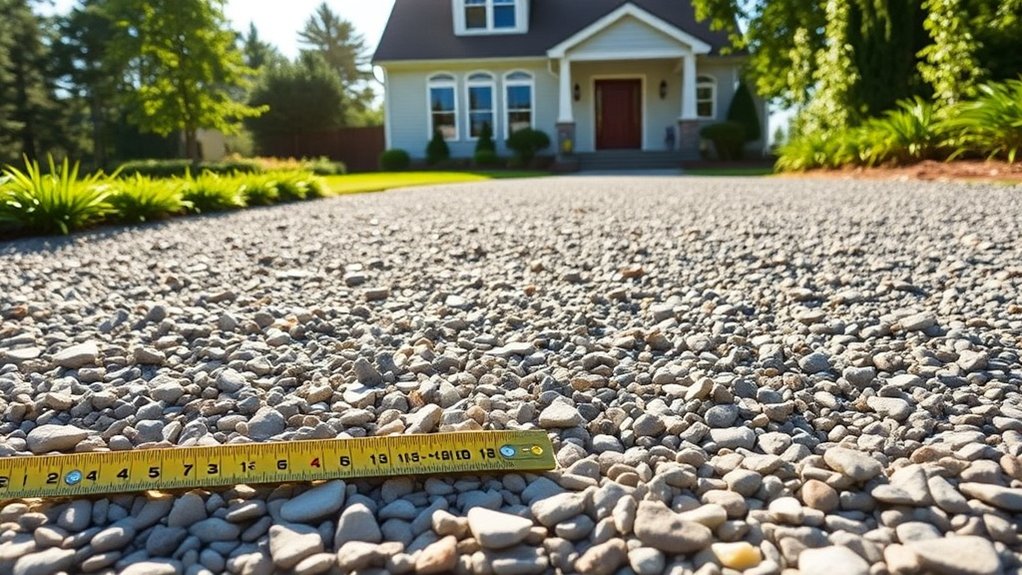
A well-installed gravel driveway not only boosts your home’s curb appeal but also provides a robust surface for vehicle access.
Start with proper site preparation: excavate 150 to 300mm deep, ensuring to remove any organic material for stability. Use stakes or string lines to mark out boundaries and shape the subgrade with a gentle crown to facilitate water runoff.
For gravel selection, choose angular or crushed gravel; lay down a 100 to 150mm coarse base layer, followed by a top layer of 50 to 100mm. Use a plate compactor after each layer to prevent settling.
Finally, install edging materials such as timber or stone to contain the gravel and maintain the driveway’s shape, ensuring it remains functional and attractive over time.
Importance of Proper Drainage Design
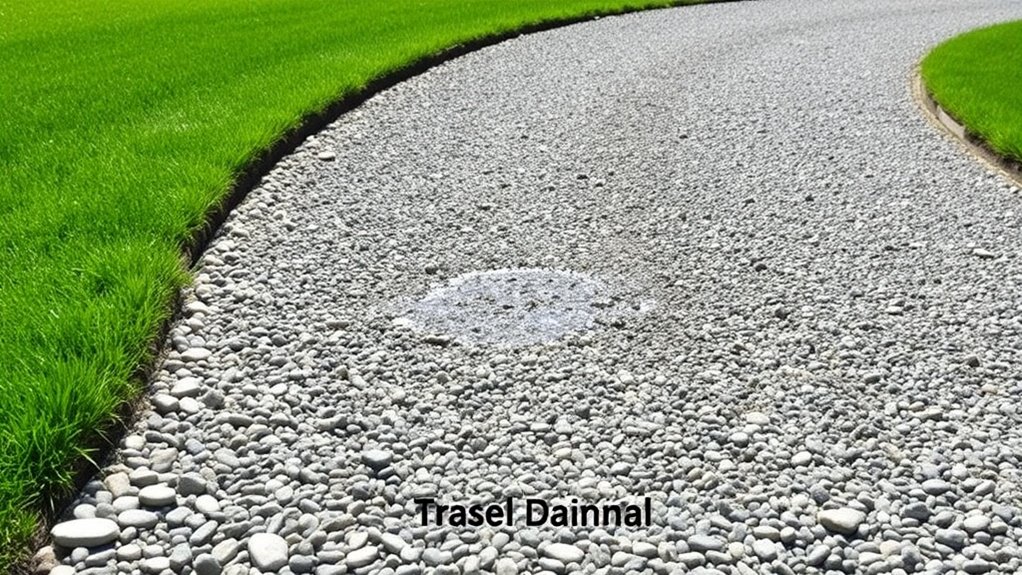
While many homeowners prioritise the look of a gravel driveway, effective drainage design is essential for its long-term performance and durability.
Proper drainage helps manage water runoff, reducing erosion and maintenance costs. Here are some key points to consider for optimal drainage:
- Create a 2-3% crown to encourage water runoff and prevent pooling.
- Add drainage ditches on the uphill side to catch runoff before it reaches the driveway.
- Use culverts or perforated pipe drains to allow subsurface water to flow away efficiently.
By implementing these strategies, you can ensure your gravel driveway remains stable and functional, minimising water-related problems.
Prioritising effective drainage not only extends the lifespan of your driveway but also safeguards your property from potential water damage.
Frequently Asked Questions
What Type of Gravel Is Best for Residential Driveways?
For residential driveways, crushed stone provides durability and stability for heavy traffic, while decorative gravel, such as pea gravel or river rock, adds visual appeal. Consider your traffic requirements and aesthetic preferences to ensure optimal performance.
How Can I Prevent Weeds in My Gravel Driveway?
To prevent weeds in your gravel driveway, consider using landscape fabric, which can reduce weed growth by up to 90%. Regular maintenance, like raking and removing debris, is essential. You might also apply organic herbicides to keep the surface tidy. Simple strategies like these can help you maintain a weed-free driveway with minimal effort.
Can I Install a Gravel Driveway Myself?
Yes, you can install a gravel driveway yourself. With the right planning, tools, and techniques, you can create a sturdy and functional surface that meets your needs and improves the look of your property. For example, make sure to properly prepare the ground and choose the right type of gravel. Regular maintenance will also help keep your driveway in good condition.
What Tools Do I Need for Gravel Driveway Installation?
You’ll need a mini digger for excavation, shovels for grading, and rakes for leveling. It’s essential to master shovelling techniques, and don’t overlook compaction tools to ensure your gravel driveway is stable and lasts well.
How Long Does a Gravel Driveway Last Before Needing Replacement?
A gravel driveway usually lasts between 10 to 20 years, depending on how much it’s used and the maintenance it receives. To prolong its lifespan and avoid early replacement, it’s important to regularly regrade and top dress the surface. Simple upkeep can make a significant difference.
Conclusion
In summary, having the correct depth for your gravel driveway is crucial for its durability and effectiveness. For example, a homeowner in a particularly wet area found that a depth of 150mm (6 inches) with proper layering helped prevent washouts and ruts, significantly extending the driveway’s lifespan. By ensuring adequate drainage and adhering to best practices, you can avoid costly repairs and maintain year-round access. A well-prepared gravel driveway not only boosts your property’s curb appeal but also enhances its longevity in various weather conditions.
Keen to enhance your driveway with the right gravel? Discover the best types and find out which one suits your Read more
How to enhance your gravel driveway's stability and durability? Discover key strategies that can transform your drive into a long-lasting Read more
Uncover the essential differences between gravel driveways and tarmac, and find out which option truly suits your needs best.

